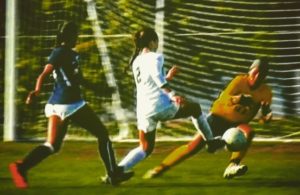- 2019/2020 Recap: Lady Scots Conquer First Round of CIF!
- 2019 Recap: Justin Flowe Wins the Dick Butkus Award
- Upland Lady Scots Have Their Revenge
- What is BBCOR?
- Tommy John, A Name To Be Feared
- The Game Plan
- Too Much Tackle?
- Is Cheer A Sport?
- Transgender Inclusion in Youth Sports
- Are You Counting Sheep Right?
Anorexia Athletica
- Updated: October 7, 2014

Children, at ever younger ages, seem to be concerned with weight loss and physical appearance. NIH research reports worrisome statistics: 70% of high school girls and 30% of high school boys exercise and diet to lose weight or prevent weight gain. Even as young as 4th grade, 60% of girls and 40% of boys resort to dieting in order to be thinner.
Unsupervised dieting is particularly problematic for growing adolescents and young athletes. The trend in gymnastics has led to ever lower than normal body weights, and nutrient deficiencies and pathogenic weight-control behaviors is common among wrestlers. In girls, excessive exercise and dieting may delay the onset of puberty. Post pubescent girls can experience irregular or complete lack of menstruation which leads to premature bone demineralization, osteoporosis and bone fractures. Athletic fitness, including anaerobic capacity, is greatly hurt by improper eating habits.
Driven athletes, particularly in sports where small size or making weight influence success, sometimes resort to unhealthy strategies like excessive exercise, binge eating or dieting. Self-starvation and excessive exercise are both symptoms of a psychological disorder called anorexia nervosa, and in recent years athletes who exhibit some of the characteristics of this disorder have been described as having anorexia athletica.
The bulk of the professional career of an elite female gymnasts or dancer occurs in her early, mid and late teen years. An elite gymnast works out 40 hours per week, constantly putting her body at high risk of repetitive stress fractures, feet, knee and back problems. Since gymnastics is competing against the resistance of the athlete’s weight, being small and thin is an advantage. In 1996, the American Medical Association called gymnastics training “child abuse” citing numerous injuries and long-term medical problems. Sportswriter Joan Ryan expressed concern about women’s gymnastics and figure skating in her book Little Girls in Pretty Boxes: “When one combines the high-achiever personality type of the elite gymnast, the abusive methods of the coaches, the unforgiving aesthetic standards of the judges, and the spoken or unspoken pressure from the parents, the sport is a petri dish of disaster.” Christy Henrich, who battled bulimia for four years, died from multiple organ failure, and Julissa Gomez broke her neck died after three years in a coma.
Added to the same physical pressures of gymnastics, the aesthetic pressure of ballet compounds eating disorders among dancers. Dance is a highly competitive, high-pressure and physically demanding profession. There is also an ideal body type for female dancers known as the “Balanchine” body type: tall, slender women with long necks, long legs and short torsos. There are so many problems with eating disorders that many nutritionists and therapists specialize in the emotional and physical problems among dancers. Despite increasing positive attitudes and awareness, eating disorders in ballet remain extremely difficult to treat. Director of research at the Harkness Center for Dance Injuries, Marijeanne Liderbach, explained: ”People attracted to dance may be looking for that kind of structure. ‘Achieving a triple pirouette or 105 on the scale are tangible goals in a difficult world.”
Wrestling requires a slim, lean body build and many wrestlers try to “cut” to a lower weight class in order to gain an advantage over smaller opponents. Weight-cutting practices include fasting from water and food, increased exercise, and using saunas, plastic workout suits, vomiting and laxatives. Normal weight loss is about 2 lbs a week, but wrestlers will lose more than 5.5 lbs within 24-48 hours before weigh-in. After this, the wrestler binge eats and attempts to rehydrate. This is common not only for college and professional athletes but also among young high school athletes who are still growing.
In Japan, sumo wrestlers have the opposite problem. It turns out that bigger isn’t always better. Sumo wrestler champions Konishiki (Salevaa Atisanoe) and Akebono (Chad Rowan), both from Hawai’i, achieved ring success due to their huge weights. Konishiki retired recently at age 34 and a peak weight of 630 pounds. Injuries aggravated and probably caused to his large size forced his early retirement. In 1997, sumo officials voiced concern over the increase in weight-related injuries.
Self-starvation, weight cutting, binge eating, and excessive exercise all influence unhealthy attitudes about food and exercise. These behaviors can lead to developing eating disorders and, in general, has as much of a negative effect on the athlete’s health as doping.
—————————————————————————————————————————-
Author: Melanie Carbine
Melanie Carbine currently writes for several education blogs, vlogs about her travels, and teaches middle school in the DC Metro Area.
Copyright © 2023 KSNN. All rights reserved.








